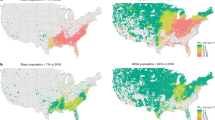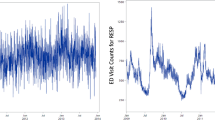Abstract
Background
To capture the impacts of environmental stressors, environmental indices like the Air Quality Index, Toxic Release Inventory, and Environmental Quality Index have been used to investigate the environmental quality and its association with public health issues. However, past studies often rely on relatively small sample sizes, and they have typically not adjusted for important individual-level disease risk factors.
Objective
We aim to estimate associations between existing environmental indices and asthma prevalence over a large population and multiple years.
Methods
Based on data availability, we assessed the predictive capability of these indices for prevalent asthma across U.S. counties from 2003 to 2012. We gathered asthma data from the U.S. CDC Behavioral Risk Factor Surveillance System by county and used multivariable weighted logistic regression models to estimate the associations between the environmental indices and asthma, adjusting for individual factors such as smoking, income level, and obesity.
Results
Environmental indices showed little to no correlation with one another and with prevalent asthma over time. Associations of environmental indices with prevalent asthma were very weak; whereas individual factors were more substantially associated with prevalent asthma.
Significance
Our study suggests that an improved environmental index is needed to predict population-level asthma prevalence.
This is a preview of subscription content, access via your institution
Access options
Subscribe to this journal
Receive 6 print issues and online access
$259.00 per year
only $43.17 per issue
Buy this article
- Purchase on Springer Link
- Instant access to full article PDF
Prices may be subject to local taxes which are calculated during checkout




Similar content being viewed by others
References
Heron M. Deaths: leading causes for 2017. Natl Vital Stat Rep. 2019;68:77.
Xu J, Murphy SL, Kochanek KD, Bastian BA. Deaths: final data for 2013. Natl Vital Stat Rep. 2016;64:1–119.
Künzli N, Kaiser R, Medina S, Studnicka M, Chanel O, Filliger P, et al. Public-health impact of outdoor and traffic-related air pollution: a European assessment. Lancet. 2000;356:795–801.
Guarnieri M, Balmes JR. Outdoor air pollution and asthma. Lancet. 2014;383:1581–92.
OSHA. OSHA Annotated PELs. https://www.osha.gov/dsg/annotated-pels/ (accessed 12 Dec 2019).
Kim JJ, Smorodinsky S, Lipsett M, Singer BC, Hodgson AT, Ostro B. Traffic-related air pollution near busy roads. Am J Respir Crit Care Med. 2004;170:520–6.
McKenzie LM, Witter RZ, Newman LS, Adgate JL. Human health risk assessment of air emissions from development of unconventional natural gas resources. Sci Total Environ. 2012;424:79–87.
U.S. EPA. Technical Assistance Document for the Reporting of Daily Air Quality – the Air Quality Index (AQI). U.S. Environmental Protection Agency, 2018. https://www3.epa.gov/airnow/aqi-technical-assistance-document-sept2018.pdf (accessed 12 Dec 2019)
He S, Tang S, Xiao Y, Cheke RA. Stochastic modelling of air pollution impacts on respiratory infection risk. Bull Math Biol. 2018;80:3127–53.
Mansfield C, Reed Johnson F, Van, Houtven G. The missing piece: Valuing averting behavior for children’s ozone exposures. Resour Energy Econ. 2006;28:215–28.
Neidell M. Information, avoidance behavior, and health the effect of ozone on asthma hospitalizations. J Hum Resour. 2009;44:450–78.
Wen X, Balluz L, Mokdad A. Association between media alerts of air quality index and change of outdoor activity among adult asthma in six states, BRFSS, 2005. J Community Health; N. Y. 2009;34:40–6.
Chakraborty J, Maantay JA, Brender JD. Disproportionate proximity to environmental health hazards: methods, models, and measurement. Am J Public Health. 2011;101:S27–36.
Johnson R, Ramsey-White K, Fuller CH. Socio-demographic Differences in Toxic Release Inventory Siting and Emissions in Metro Atlanta. Int J Environ Res Public Health 2016;13:747.
Moore RJH, Hotchkiss JL. The importance of toxicity in determining the impact of hazardous air pollutants on the respiratory health of children in Tennessee. Environ Pollut. 2016;216:616–23.
Messer LC, Jagai JS, Rappazzo KM, Lobdell DT. Construction of an environmental quality index for public health research. Environ Health. 2014;13:39.
Grabich SC, Rappazzo KM, Gray CL, Jagai JS, Jian Y, Messer LC and Lobdell DT. Additive Interaction between Heterogeneous Environmental Quality Domains (Air, Water, Land, Sociodemographic, and Built Environment) on Preterm Birth. Front. Public Health 2016;4:232.
Gray CL, Lobdell DT, Rappazzo KM, Jian Y, Jagai JS, Messer LC, et al. Associations between environmental quality and adult asthma prevalence in medical claims data. Environ Res. 2018;166:529–36.
Patel AP, Jagai JS, Messer LC, Gray CL, Rappazzo KM, Deflorio-Barker SA, et al. Associations between environmental quality and infant mortality in the United States, 2000–2005. Arch Public Health. 2018;76:60.
Rappazzo KM, Messer LC, Jagai JS, Gray CL, Grabich SC, Lobdell DT. The associations between environmental quality and preterm birth in the United States, 2000–2005: a cross-sectional analysis. Environ Health. 2015;14:50.
Jagai JS, Messer LC, Rappazzo KM, Gray CL, Grabich SC, Lobdell DT. County-level cumulative environmental quality associated with cancer incidence. Cancer. 2017;123:2901–8.
Chang Q, Liu S, Chen Z, Zu B, Zhang H. Association between air pollutants and outpatient and emergency hospital visits for childhood asthma in Shenyang city of China. Int J Biometeorol. 2020;64:1539–48.
Gent JF, Triche EW, Holford TR, Belanger K, Bracken MB, Beckett WS, et al. Association of low-level ozone and fine particles with respiratory symptoms in children with asthma. JAMA. 2003;290:1859–67.
U.S. CDC. Behavioral risk factor surveillance system survey data. Atlanta, GA: U.S. Department of Health and Human Services, Centers for Disease Control and Prevention; 2013.
Lobdell DT, Messer JL, Rappazzo K, Messier K, Smith G, Pierson S, et al. Environmental quality index - overview report. Washington, DC: U.S. Environmental Protection Agency; 2014.
U.S. EPA. Air Data Website File Download. 2019. https://aqs.epa.gov/aqsweb/airdata/download_files.html#Daily (accessed 25 Dec 2019).
US EPA. Toxics Release Inventory (TRI) Program. US EPA. 2013. https://www.epa.gov/toxics-release-inventory-tri-program (accessed 8 Mar 2019).
Osei AD, Mirbolouk M, Orimoloye OA, Dzaye O, Uddin SMI, Dardari ZA, et al. The association between e-cigarette use and asthma among never combustible cigarette smokers: behavioral risk factor surveillance system (BRFSS) 2016 & 2017. BMC Pulm Med. 2019;19:180.
Rummo PE, Feldman JM, Lopez P, Lee D, Thorpe LE, Elbel B. Impact of changes in the food, built, and socioeconomic environment on BMI in US counties, BRFSS 2003-2012. Obesity. 2020;28:31–9.
US Centers for Disease Control and Prevention (CDC). Behavioral Risk Factor Surveillance System Data. Atlanta, Georgia: U.S. Department of Health and Human Services, Centers for Disease Control and Prevention, 2017. https://www.cdc.gov/brfss/annual_data/2017/pdf/compare-2017-508.pdf (accessed 19 January 2021).
US Centers for Disease Control and Prevention (CDC). Behavioral Risk Factor Surveillance System Data. Atlanta, Georgia: U.S. Department of Health and Human Services, Centers for Disease Control and Prevention, 2021. https://www.cdc.gov/asthma/brfss/default.htm (accessed 19 January 2021).
Heffler E, Crimi C, Mancuso S, Campisi R, Puggioni F, Brussino L, et al. Misdiagnosis of asthma and COPD and underuse of spirometry in primary care unselected patients. Respir Med. 2018;142:48–52.
Koleade A, Farrell J, Mugford G, Gao Z Prevalence and Risk Factors of ACO (Asthma-COPD Overlap) in Aboriginal People. J Environ Public Health. 2018;2018:1–9.
Mirabelli MC, Beavers SF, Chatterjee AB, Moorman JE. Age at asthma onset and subsequent asthma outcomes among adults with active asthma. Respir Med. 2013;107:1829–36.
Schneider KL, Clark MA, Rakowski W, Lapane KL. Evaluating the impact of non-response bias in the Behavioral Risk Factor Surveillance System (BRFSS). J Epidemiol Community Health. 2010;66:290–5.
Torén K, Palmqvist M, Löwhagen O, Balder B, Tunsäter A. Self-reported asthma was biased in relation to disease severity while reported year of asthma onset was accurate. J Clin Epidemiol. 2006;59:90–3.
US Centers for Disease Control and Prevention (CDC). Behavioral risk factor surveillance system data. Atlanta, Georgia: U.S. Department of Health and Human Services, Centers for Disease Control and Prevention; 2009. https://www.cdc.gov/brfss/smart/2009/compare_09.pdf (accessed 19 January 2021).
Winkler R, Johnson KM, Cheng C, Beaudoin J, Voss PR, Curtis KJ. Age-specific net migration estimates for US counties, 1950–2010. Applied Population Laboratory, University of Wisconsin - Madison, 2013. Web. https://netmigration.wisc.edu/ (accessed 28 January 2021)
Lobdell DT, Jagai JS, Rappazzo K, Messer LC. Data sources for an environmental quality index: availability, quality, and utility. Am J Public Health. 2011;101:S277–85.
Ekström S, Magnusson J, Kull I, Andersson N, Bottai M, Besharat Pour M, et al. Body mass index development and asthma throughout childhood. Am J Epidemiol. 2017;186:255–63.
Hancox RJ, Milne BJ, Poulton R, Taylor DR, Greene JM, McLachlan CR, et al. Sex differences in the relation between body mass index and asthma and atopy in a birth cohort. Am J respiratory Crit care Med. 2005;171:440–5.
Greenblatt R, Mansour O, Zhao E, Ross M, Himes BE. Gender-specific determinants of asthma among U.S. adults. Asthma Res Pract. 2017;3:2.
Boulet L-P, Boulay M-È, Dérival J-L, Milot J, Lepage J, Bilodeau L, et al. Asthma-COPD overlap phenotypes and smoking: comparative features of asthma in smoking or non-smoking patients with an incomplete reversibility of airway obstruction. COPD. 2018;15:130–8.
Bates JHT, Poynter ME, Frodella CM, Peters U, Dixon AE, Suratt BT. Pathophysiology to phenotype in the asthma of obesity. Ann ATS. 2017;14:S395–8.
Cardet JC, Louisias M, King TS, Castro M, Codispoti CD, Dunn R, et al. Income is an independent risk factor for worse asthma outcomes. J Allergy Clin Immunol. 2018;141:754–60.e3.
Akinbami LJ, Schoendorf KC. Trends in childhood asthma: prevalence, health care utilization, and mortality. Pediatrics. 2002;110:315–22.
Fitzpatrick AM, Gillespie SE, Mauger DT, Phillips BR, Bleecker ER, Israel E, et al. Racial disparities in asthma-related health care use in the National Heart, Lung, and Blood Institute’s Severe Asthma Research Program. J Allergy Clin Immunol. 2019;143:2052–61.
Albataineh E, Al-Zayadneh E, Al-Shagahin H, Soloman AL, Altarawneh A, Aldmour A, et al. Control and its predictive factors in adult asthma patients. J Clin Med Res. 2019;11:807–17.
de Marco R, Pesce G, Marcon A, Accordini S, Antonicelli L, Bugiani M, et al. The coexistence of asthma and chronic obstructive pulmonary disease (COPD): prevalence and risk factors in young, middle-aged and elderly people from the general population. PLoS ONE. 2013;8:e62985.
Fishwick D. New occupational and environmental causes of asthma and extrinsic allergic alveolitis. Clin Chest Med. 2012;33:605–16.
Haikerwal A, Akram M, Sim MR, Meyer M, Abramson MJ, Dennekamp M. Fine particulate matter (PM2.5) exposure during a prolonged wildfire period and emergency department visits for asthma. Respirology. 2016;21:88–94.
Schultz AA, Schauer JJ, Malecki KM. Allergic disease associations with regional and localized estimates of air pollution. Environ Res. 2017;155:77–85.
Kosnik MB, Reif DM, Lobdell DT, Astell-Burt T, Feng X, Hader JD, et al. Associations between access to healthcare, environmental quality, and end-stage renal disease survival time: Proportional-hazards models of over 1,000,000 people over 14 years. PLOS ONE. 2019;14:e0214094.
Choi HS, Shim YK, Kaye WE, Ryan PB. Potential residential exposure to toxics release inventory chemicals during pregnancy and childhood brain cancer. Environ Health Perspect. 2006;114:1113–8.
Perlmutt L, Stieb D, Cromar K. Accuracy of quantification of risk using a single-pollutant Air Quality Index. J Expo Sci Environ Epidemiol. 2017;27:24–32.
Perlmutt LD, Cromar KR. Comparing associations of respiratory risk for the EPA Air Quality Index and health-based air quality indices. Atmos Environ. 2019;202:1–7.
Breysse PN, Diette GB, Matsui EC, Butz AM, Hansel NN, McCormack MC. Indoor air pollution and asthma in children. Proc Am Thorac Soc. 2010;7:102–6.
Acknowledgements
The authors thank Kate Dunkelberger for her edits to parts of the manuscript.
Funding
Support for this work was provided by grant NIH R01ES029528.
Author information
Authors and Affiliations
Corresponding author
Ethics declarations
Conflict of interest
The authors declare no competing interest.
Additional information
Publisher’s note Springer Nature remains neutral with regard to jurisdictional claims in published maps and institutional affiliations.
Rights and permissions
About this article
Cite this article
Hurbain, P., Liu, Y., Strickland, M.J. et al. A cross-sectional analysis of associations between environmental indices and asthma in U.S. counties from 2003 to 2012. J Expo Sci Environ Epidemiol 32, 320–332 (2022). https://doi.org/10.1038/s41370-021-00326-4
Received:
Revised:
Accepted:
Published:
Issue Date:
DOI: https://doi.org/10.1038/s41370-021-00326-4



